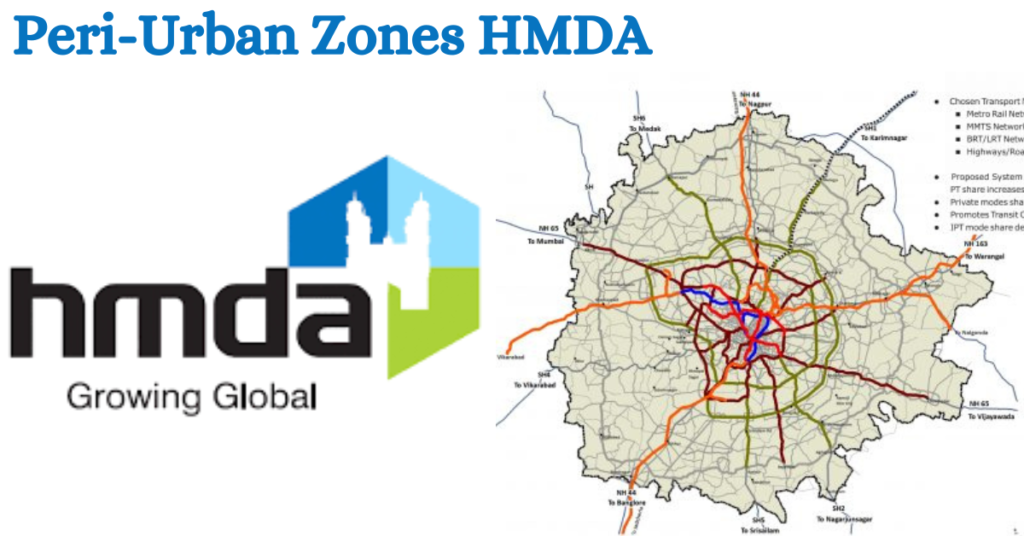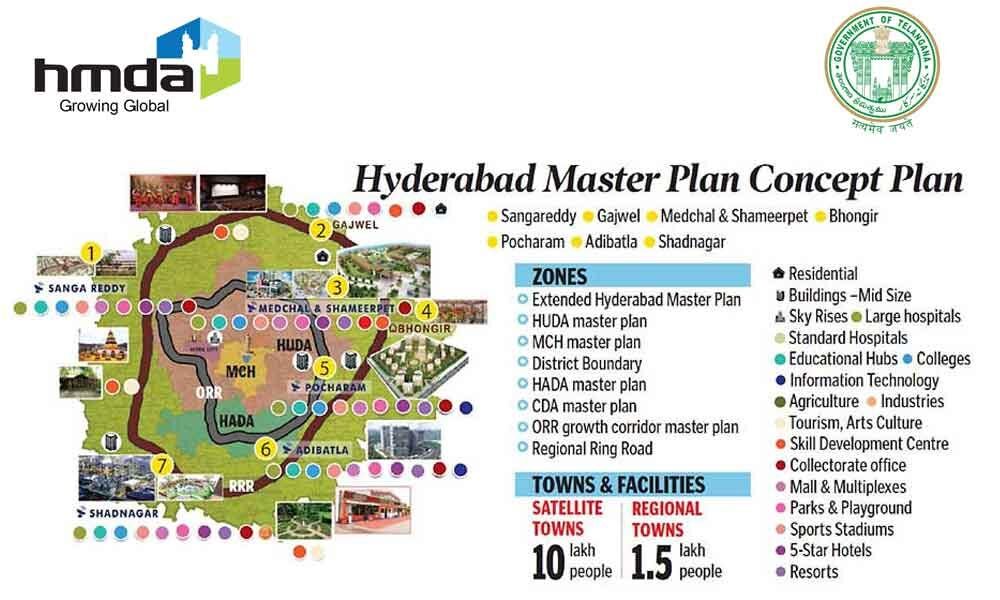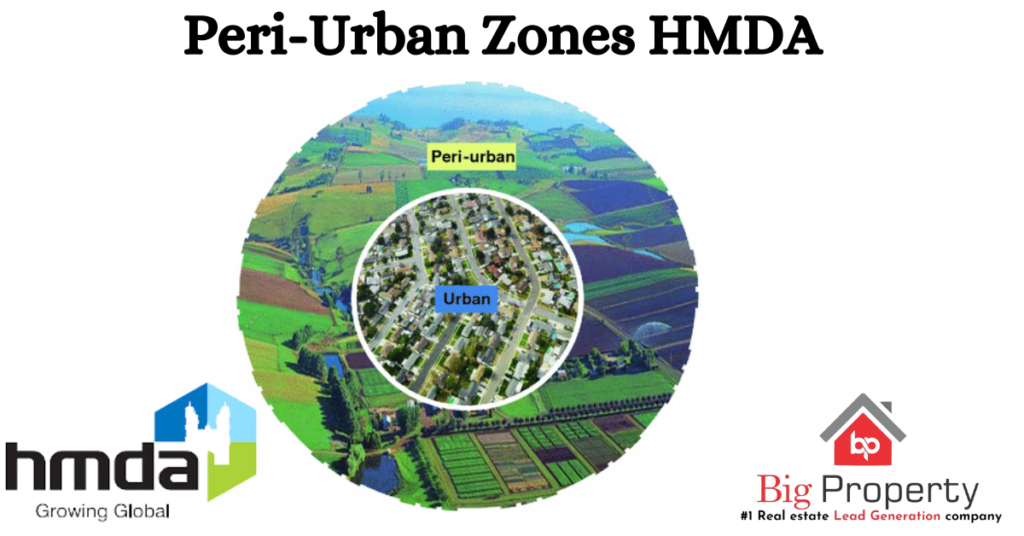Introduction:
PERI-Urban Zones in Hyderabad a bustling metropolis in Telangana, India, is characterized by a diverse urban landscape that encompasses various zones, each with its unique characteristics and development potential. Understanding these zones is crucial for comprehending the city’s urban planning, economic development, and social dynamics.
What are PERI-Urban Zones in Hyderabad HMDA?
PERI-Urban Zones in Hyderabad are areas located on the outskirts of the city, serving as a transition between the densely populated urban core and the surrounding rural areas. These zones often experience rapid growth and development, as they are attractive to both residential and commercial activities due to their proximity to the city center and lower land costs compared to the central business district.
Key Points of PERI-Urban Zones in Hyderabad HMDA:
Location: On the outskirts of Hyderabad, often along major transportation corridors.
Mixed land uses: These zones typically have a mix of residential, commercial, and industrial land uses.
Infrastructure development: PERI-Urban Zones in Hyderabad often witness significant infrastructure development, including new roads, highways, and public transportation systems.
Growth potential: Due to their proximity to the city center and lower land costs, these zones have high growth potential for both residential and commercial development.
Examples: Some well-known PERI-Urban Zones in Hyderabad include areas like Kondapur, Gachibowli, Kukatpally, and Madhapur.
Challenges and opportunities:
Traffic congestion: Rapid urbanization in PERI-Urban Zones can lead to traffic congestion and increased pollution.
Infrastructure development: While infrastructure development is essential for growth, it can also strain resources and lead to environmental concerns.
Land use planning: Effective land use planning is crucial to ensure sustainable development and avoid urban sprawl in these areas.
Overall, PERI-Urban Zones in Hyderabad play a vital role in the city’s expansion and development. However, careful planning and management are essential to address the challenges associated with rapid growth and ensure a sustainable future for these areas.

Also Read: What About Residential Zones in Hyderabad Metropolitan Development Authority (HMDA)
Permitted Uses in Peri-Urban Zones
The Peri-Urban Zone is a versatile area on the outskirts of urban centers that supports a variety of land uses. These uses are categorized into several key types, each with specific regulations to ensure balanced development and functionality. Here’s an overview of the permitted uses within these zones:
1. Residential
All Types of Residential Buildings: Permitted with ground coverage not exceeding 25%. This includes houses, apartments, and villas, ensuring adequate space for residential living while maintaining open areas.
2. Recreational
Bird Sanctuaries: Areas designated for the protection and observation of birds.
Botanical/Zoological Gardens: Spaces dedicated to the collection and conservation of plant and animal species.
Camping Grounds: Designated areas for temporary stays in tents or similar accommodations.
Children’s Traffic Parks: Safe, educational spaces for children to learn about road safety and traffic rules.
Local Parks: Small, community-focused recreational spaces.
Picnic Huts: Structures for picnicking with a built-up area not exceeding 5%.
Playgrounds: Areas equipped with recreational facilities for children.
Regional Parks: Larger parks offer diverse recreational and natural experiences.
3. Commercial
Commercial Use of Transit Nature: Includes temporary commercial activities like circuses.
Film Studios/Cities: Requires a minimum plot area of 10 acres with ground coverage not exceeding 15%.
Function Halls: Permitted on plots larger than 3000 sq. mts with roads of at least 18 meters in width.
Holiday Resorts: Requires a minimum plot of 10 acres with ground coverage not exceeding 10%.
Educational Institutions: Includes schools and colleges with a minimum plot of 10 acres and ground coverage not exceeding 15%.
Petrol Pumps: Facilities for fuel distribution.
Restaurants as Part of Sports/Recreational Outdoor Facilities: Limited to a ground coverage of 5% within larger recreational spaces.
4. Public Services
Banks: Financial institutions providing banking services.
Bus Stands: Facilities for public transportation.
Clinics/Dispensaries/Primary Health Sub-Centers: Health care facilities providing medical services.
Community Centers and Social Institutions: Places for community activities and social services.
Municipal/State/Central Government Offices: Government administrative offices.
Professional Offices/Personal Services Establishments: Offices and service centers for professional and personal services.
Public Utilities and Buildings: Includes essential services and infrastructure, excluding service and storage yards.
Religious Places: Facilities for worship and other religious activities.
Repair Service Establishments: Businesses providing repair and maintenance services.
Schools: Educational institutions offering primary and secondary education.
5. Sports & Leisure
Outdoor/Indoor Sports Stadiums: Facilities for various sports events and activities.
Open-Air Cinemas/Auditoria: Venues for film screenings and performances.
Shooting Ranges: Designated areas for target practice.
Specialized Parks/Maidans for Multi-Use: Parks designed for various recreational activities.
Sports Training Centers: Facilities for training athletes and sports enthusiasts.
Swimming Pools: Pools with built-up areas not exceeding 5% of the total area, providing recreational and fitness opportunities.
6. Other
Building and Structures Ancillary to Permitted Uses: Includes support structures in open spaces and parks with ground coverage not exceeding 5%.
Water Bodies: Natural or artificial bodies of water, such as lakes or ponds, integrated into the landscape for ecological and aesthetic purposes.
Also Read: Streamlining Construction Permits: HMDA’s Digital Revolution

Prohibited Activities in Peri-Urban Zones of Hyderabad HMDA
While peri-urban zones in Hyderabad offer a range of development opportunities, certain activities are generally prohibited or restricted to maintain the character of these areas and ensure sustainable growth. Some common prohibitions include:
Industrial Activities: Heavy industries that may cause pollution or noise pollution are typically not allowed in peri-urban zones.
Hazardous Activities: Activities involving hazardous materials or processes, such as chemical manufacturing or waste disposal, are generally prohibited.
Agricultural Activities: Large-scale agricultural activities may be restricted or prohibited in peri-urban zones to prevent encroachment on urban areas.
Unauthorized Construction: Any construction activity that does not comply with local zoning regulations or building permits is prohibited.
Illegal Dumping: Dumping of waste or debris in unauthorized areas is strictly prohibited and can lead to fines or legal action.

Also Read: What to Check Before Buying a Plot in an HMDA Project?
Permitted uses and prohibited activities in Peri-Urban Zones in Hyderabad HMDA:
| Category | Permitted Uses | Prohibited Activities |
|---|---|---|
| Residential | – All types of residential buildings (ground coverage ≤ 25%) | – |
| Recreational | – Bird sanctuaries – Botanical/zoological gardens – Camping grounds – Children’s traffic parks – Local parks – Picnic huts (built-up area ≤ 5%) – Playgrounds – Regional parks | – |
| Commercial | – Commercial use of transit nature (e.g., circuses) – Film studios/cities (min. plot area 10 acres, ground coverage ≤ 15%) – Function halls (plots ≥ 3000 sq. mts, roads ≥ 18 meters) – Holiday resorts (min. plot 10 acres, ground coverage ≤ 10%) – Educational institutions (min. plot 10 acres, ground coverage ≤ 15%) – Petrol pumps – Restaurants as part of sports/recreational outdoor facilities (ground coverage ≤ 5%) | – Industrial activities (heavy industries causing pollution or noise) – Hazardous activities (e.g., chemical manufacturing) |
| Public Services | – Banks – Bus stands – Clinics/dispensaries/primary health sub-centers – Community centers and social institutions – Municipal/state/central government offices – Professional offices/personal services establishments – Public utilities and buildings (excluding service and storage yards) – Religious places – Repair service establishments – Schools | – Unauthorized construction (not complying with local regulations or permits) |
| Sports & Leisure | – Outdoor/indoor sports stadiums – Open-air cinemas/auditoria – Shooting ranges – Specialized parks/maidans for multi-use – Sports training centers – Swimming pools (built-up area ≤ 5%) | – |
| Other | – Building and structures ancillary to permitted uses (ground coverage ≤ 5%) – Water bodies | – Agricultural activities (large-scale agriculture may be restricted) – Illegal dumping (waste or debris in unauthorized areas) |
Conclusion:
The Peri-Urban Zones in Hyderabad serve as crucial transitional areas between the city’s dense urban core and the surrounding rural spaces. These zones offer a blend of residential, recreational, commercial, public, and leisure uses, reflecting their role in accommodating growth and providing diverse functionalities. The flexibility in land use within these zones supports the city’s expansion while addressing various needs from housing to recreational facilities. However, with rapid development come challenges such as traffic congestion and environmental impacts, necessitating careful planning and management to ensure sustainable growth.
Frequently Asked Questions:
Areas on the outskirts of Hyderabad bridging urban and rural spaces with diverse land uses.
15 meters for residential and 18 meters for non-residential buildings.
Bird sanctuaries, botanical gardens, parks, playgrounds, and camping grounds.
Yes, including film studios, function halls, holiday resorts, and petrol pumps.
Banks, clinics, community centers, government offices, and schools.
Suggested Articles:
What About Residential Zones in Hyderabad Metropolitan Development Authority (HMDA)
Latest News On HMDA Limits Extension: What they are?
What to Check Before Buying a Plot in an HMDA Project?







































